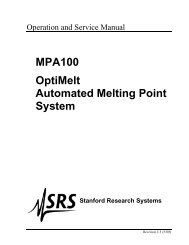Quartz Crystal Microbalance Theory and Calibration - Stanford ...
Quartz Crystal Microbalance Theory and Calibration - Stanford ...
Quartz Crystal Microbalance Theory and Calibration - Stanford ...
You also want an ePaper? Increase the reach of your titles
YUMPU automatically turns print PDFs into web optimized ePapers that Google loves.
www.thinkSRS.com<br />
lagging current via the motional arm, in order to achieve the zero phase<br />
condition. This requires the circuit run above series resonance, where the net<br />
reactance of C m <strong>and</strong> L m is inductive. In fact, if R m is large enough, it is possible<br />
that the motional arm will not be able to contribute enough lagging current to<br />
cancel the leading current via C o , <strong>and</strong> the circuit will not oscillate at all.<br />
AGC<br />
Amp<br />
L m<br />
C 0<br />
C m<br />
R m<br />
R L<br />
C v<br />
Figure 3. Oscillator Circuit with Varactor Nulling of C 0 .<br />
A method to cancel C o is shown in Figure 3. In this circuit the AGC amplifier<br />
drives a transformer with two secondary windings. One secondary drives the<br />
crystal <strong>and</strong> load as before, while the other secondary inverts the voltage. The<br />
inverted voltage source injects a current via an adjustable capacitor, C v , to cancel<br />
the current injected via C o . Exact cancellation is achieved when the adjustable<br />
capacitor is made equal to C o . In the SRS QCM25 <strong>Crystal</strong> Controller, C v is a<br />
varactor, which is made equal to C o by finding the bias setting which<br />
minimizes the gain required to sustain oscillation.<br />
AGC<br />
Amp<br />
L m<br />
C m<br />
R m<br />
ZL m + ZC m = 0<br />
R L<br />
Figure 4. Oscillator Circuit Model with C 0 cancelled by C v .<br />
With C o canceled the circuit simplifies to that shown in Figure 4. For this circuit,<br />
the zero phase condition is achieved at series resonance where the<br />
reactance of C m <strong>and</strong> L m cancel. At series resonance R m <strong>and</strong> R L form a resistive<br />
<strong>Stanford</strong> Research Systems (408)744-9040

















